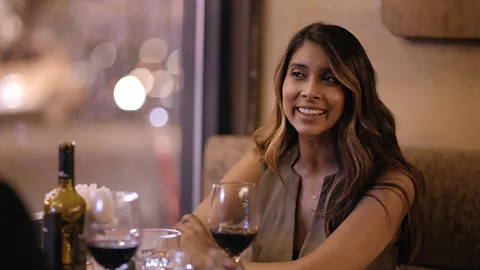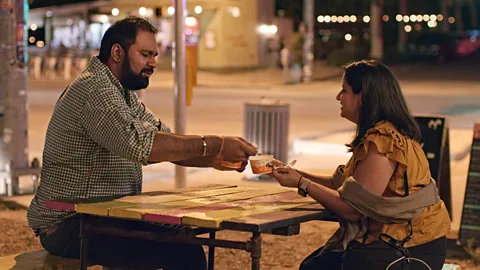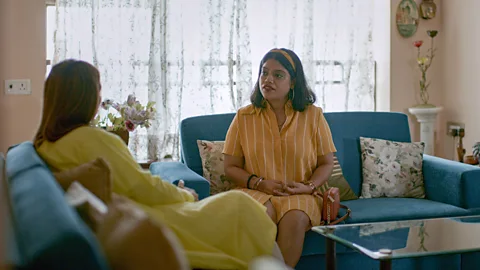Indian Matchmaking: The reality show that's divided viewers
 Netflix
NetflixLockdown hit Indian Matchmaking has inspired difficult conversations about the realities of the Indian marriage industry, explains Charukesi Ramadurai. She assesses its impact.
Right at the beginning of the Netflix hit show Indian Matchmaking, Sima Taparia, or Sima Mami (Aunty), as she calls herself, declares, “In India we don’t say ‘arranged marriage’. There is marriage and then there is ‘love marriage’.” That is probably the truest statement she makes on this show, which in its first season, takes viewers into the homes and hearts of men and women looking to find a life partner through a matchmaker. These men and women – or boys and girls, as they are referred to in Indian society, perhaps to reinforce their youth and innocence – of Indian origin are in their 20s and 30s, living in India and the US.
More like this:
Taparia, who claims to be Mumbai’s top matchmaker, travels frequently to New Jersey, New Delhi, and wherever else her services are required. At home in Mumbai, we see her husband helping her sift through a stack of ‘biodata’ – elaborate profiles of people who have registered with her, complete with head shots – mentally swiping left or right. But then, she also says at some point in the show that “In India, the marriages are between two families”, and so the real test of compatibility in her mind is between the families – or more precisely, their social status.
 Netflix
NetflixHate it or love it – and there are enough people who fall in both camps – it’s impossible to ignore Indian Matchmaking, which has inspired conversation, and memes, on social media. And if that is not a measure of the show’s success, then what is? The most popular memes are around an oft-repeated line from Taparia – “My efforts are meaningless if the stars are not aligned” – and her constant emphasis on how her (female) clients need to be “flexible” – in other words, be ready to trade off their dreams for a potentially ideal partner.
The Western world views the notion of ‘arranged marriage’ with horrified fascination; how can two adults consent to marry someone chosen for them by others? In India, though, it’s estimated that 90% of all marriages are still arranged, where the onus of finding a ‘suitable’ match for a person is on the family elders. Indian Matchmaking just takes this concept further. As Ankita Bansal, a participant from New Delhi (who eventually chose to focus on her budding business) tells BBC Culture over email, “Matchmaker way, why not? For me it wasn’t very different from being introduced to a guy by a friend or through a dating app. Of course, each of these comes with their own good, bad and ugly. I think the entire experience felt like going on a journey with no idea as to what could turn up next.” Similarly, for Aparna Shewakramani, a lawyer from Houston, it was just another way of meeting new people. “I assumed the matchmaker would work with me, listen to my preferences and use her network to find me the perfect match,” she says.
The long history of the matchmaker
There have always been matchmakers and, more recently, marriage agencies that connected families. And every Indian family has a Sima Mami who offers (women) unsolicited, and often blunt, advice to wear more make-up, or hit the gym to lose weight, if they ever hope to get married. Or there are the matrimonial columns in newspapers and on websites, rife with specifications on caste and class, and euphemisms like ‘wheatish complexion’ for someone with a darkish skin tone. As adman and social commentator Santosh Desai writes in his 2010 book Mother Pious Lady: Making Sense of Everyday India – the title a dig at the kind of information matrimonial advertisements think relevant to provide – “a person becomes a bundle of saleable attributes encrypted into matrimonial jargon”.
Despite this sociocultural context, Indian Matchmaking has generated a lot of outrage, with critics and viewers alike accusing the show of playing up – or, at the very least, not critiquing – everything regressive in Indian society. Words like hate-watch and cringe-fest have regularly featured on social media. For many women, the show was triggering, because of the way it has shone the spotlight on how intelligent, ambitious, successful women are reduced to a set of stereotypical adjectives.
 Netflix
NetflixThroughout the show, Taparia comments on how it is easy to find matches for women who are physically attractive, or “tall, fair and trim”, giving rise to accusations that the show promotes colourism. She comments equally on how difficult the process is for women who have a mind of their own, variously describing them as fickle-minded, fussy and stubborn, and advising them to be more “flexible” and open to “compromise.” Aparna (who won my heart when she said “There’s nothing about me that I think I need to change, or evolve, or grow into”) says about this, “It is true that the way this process was portrayed shows different standards for men and women, such as when I am called stubborn for rejecting one match but the men who turn down over 100 women are just unsure.” And male contestant Vyasar Ganesan, a 27-year-old teacher from Texas, spoke to Scroll.in about the casual dismissal of women, calling it “painful to watch”.
However, not everyone agrees that all the criticism about this show is valid, saying it merely holds a mirror to Indian society, warts and all. Suchitra Govindarajan, a writer from Bangalore, admits that she was ready to ‘hate-watch’ the show but ended up liking it for its laidback pace – “perfect lockdown viewing” – and the fact that it did not showcase an exotic idea of India to the West. “I’d say that the real world is much more brutal in its discrimination – matchmakers, astrologers and prospective suitors are much more crude and forthright about their expectations,” she says.
“Maybe it just makes us flinch when we see it all laid bare on international television?” Govindarajan raises a question many people agree with. Anil Kumar, founder and CEO of matchmaking platform Jodi365.com, tells BBC Culture: “If the show has evoked hashtags such as #CringeBinge, it is because many people in India can identify with the plotlines and characters, and the cringing may be more among progressive elites than the condoning majority.”
 Netflix
NetflixProducer Smriti Mundhra told Decider that Indian Matchmaking deliberately decided to “not shy away from uncomfortable conversations” such as “the way we prioritise certain things, commodify certain things”. And the show does acknowledge the participants’ anxieties and discomfort with the process, in the way the camera pans repeatedly to the uncertainty or scepticism on their faces, or zooms in on clenched hands that tell their own story.
If anything, there are those who feel that Indian Matchmaking glossed over India’s marriage industry, ignoring its dark underbelly. According to Dr Dayal Mirchandani, a psychotherapist from the Indian city of Pune, “Dowry is still a big, ugly issue in India, and I know parents who have gone bankrupt just getting their daughters married.” Referring to finishing schools for brides, where young women are coached on being ideal wives, he adds, “This show is actually like a fairy tale, because the reality is much worse.”
Govindarajan echoes that thought, telling BBC Culture: “The women in the show had more freedom and agency than many I know. This is probably due to the focus on privileged people and Indian Americans – although neither of these are guarantees of liberation in Indian society.” Kumar argues that this is merely a drama with the essential ingredients of tension and the conflict between right and wrong. He says, “It is a reality show, with the emphasis on show as much as on reality. So, let’s cut the producers some slack for giving in to commercial considerations and making it more a drama than documentary.”
Ultimately, it is not the duty of a reality show to bring about social change. It is up to the audience to look into the mirror and reflect. As Aparna says, “There is a collective feminine South Asian voice that is coming to the forefront since the show launched, and I believe a lot of good can come from this attention to these issues brought up by the show.”
Love film and TV? Join BBC Culture Film and TV Club on Facebook, a community for cinephiles all over the world.
And if you liked this story, sign up for the weekly bbc.com features newsletter, called The Essential List. A handpicked selection of stories from BBC Future, Culture, Worklife and Travel, delivered to your inbox every Friday.
